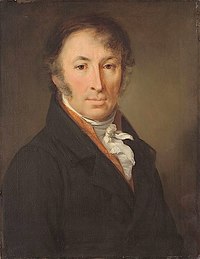
Father of Nikolay Mikhaylovich Karamzin (
Николай Михайлович Карамзин
) served as an officer in the Russian army. He was sent to Moscow to study under Swiss-German teacher Johann Matthias Schaden; he later moved to Saint Petersburg, where he made the acquaintance of Dmitriev, a Russian poet of some merit, and occupied himself with translating essays by foreign writers into his native language. After residing for some time in Saint Petersburg he went to Simbirsk, where he lived in retirement until induced to revisit Moscow. There, finding himself in the midst of the society of learned men, he again took to literary work.
In 1789, he resolved to travel, and visited Germany, France, Switzerland and England. On his return he published his Letters of a Russian Traveller, which met with great success. These letters, modelled after Irish-born Poet, Laurence Sterne´s , (1713 – 1768), Sentimental Journey, were first printed in the Moscow Journal, which he edited, but were later collected and issued in six volumes (1797-1801).
In the same periodical Karamzin also published translations from French and some original stories, including Poor Liza and Natalia the Boyar's Daughter (both 1792). These stories introduced Russian readers to sentimentalism, and Karamzin was hailed as "a Russian Sterne".
In 1794, Karamzin abandoned his literary journal and published a miscellany in two volumes entitled Aglaia, in which appeared, among other stories, The Island of Bornholm and Ilya Muromets, the latter a story based on the adventures of the well-known hero of many a Russian legend. From 1797 to 1799 he issued another miscellany or poetical almanac, The Aonides, in conjunction with Derzhavin and Dmitriev. In 1798 he compiled The Pantheon, a collection of pieces from the works of the most celebrated authors ancient and modern, translated into Russian. Many of his lighter productions were subsequently printed by him in a volume entitled My Trifles. Admired by Alexander Pushkin and Vladimir Nabokov, the style of his writings is elegant and flowing, modelled on the easy sentences of the French prose writers rather than the long periodical paragraphs of the old Slavonic school.
In 1802 and 1803 Karamzin edited the journal the European Messenger (Vestnik Evropy). It was not until after the publication of this work that he realized where his strength lay, and commenced his 12 volume History of the Russian State. In order to accomplish the task, he secluded himself for two years at Simbirsk, the Volga river town where Vladimir Ilych Ulyanov, a.k.a. Lenin, (1870 - 1924), was born. This town was known then, after Lenin, for some 60 years as Ulianovsk, while Saint Petersburg became Leningrad till around 1990.
When emperor Alexander learned the cause of his retirement, Karamzin was invited to Tver, where he read to the emperor the first eight volumes of his history. He was a strong supporter of the anti-Polish policies of the Russian Empire, and expressed hope that there would be no Poland under any shape or name In 1816 he removed to St Petersburg, where he spent the happiest days of his life, enjoying the favour of Alexander I and submitting to him the sheets of his great work, which the emperor read over with him in the gardens of the palace of Tsarskoye Selo.
He did not, however, live to carry his work further than the eleventh volume, terminating it at the accession of Michael Romanov in 1613. He died on the 22nd of May (old style) 1826, in the Taurida palace. A monument was erected to his memory at Simbirsk in 1845.









